The fruits of watermelon are known and loved by everyone, they remind many of the taste of summer, so some dacms are trying to grow this culture on their summer cottage. The watermelon plant is annual and belongs to the pool family, the nature of the watermelon. The birthplace of this famous culture is considered to be Africa. The first references to the fruits of this plant are still in the chronicles of the ancient Egyptians and Romans. From it prepared various sweets, including honey drinks. In addition, watermelons, taking into account their diuretic properties, were used for medical purposes for natural purification of the body. Today, this culture is grown on other continents. Best of all, the plant is coming around in the warm climate with a long summer period and a short winter. Next, we will tell you more on how to properly plant watermelons in the country area.
Characteristics of Arbuzov
The characteristics of the culture are as follows:
- Plants Stems reach a length of 4 m. They have a curving structure. Regardless of the fact that the fruits of culture are quite massive, the stalks grow very thin.
- Culture leaflets have an ovoid shape and omission along the edges. Length reaches 10-20 cm, width 6-17 cm.
- Plant blooms in summer. Flowers are predominantly white. Bracts grow in the form of a boat.
- The fruits of culture have a lot of seeds. The pulp juicy and soft, in the rock form has a red or pink color. The fruit is sweet.
Reproduction of watermelon
Culture culture is carried out in several ways:
- With the help of seeds.
- From seedlings.
Planting seeds of watermelon
Consider in more detail how the watermelon is underway to seeds. If culture is planned to be grown in the regions with a warm climate, the planting material without prior preparation can be immersed immediately into the soil.
The order of planting seeds of watermelon is as follows:
- It is recommended to sow planting material only when the soil on the site warmed up the solar rays to 13 degrees. For this, the seeds are kept in a container with warm water until the sprouts will be processed.
- On the site chosen for planting culture, the landing wells are made at a depth of 10 cm. The fumes are located at a distance of 100 cm apart.
- Fertilizers are placed in the landing hole (humidia with the addition of 1 art. L. Ash and 1 tsp. Ammophos).
- Further, seeds are placed in the well and sprinkled on top of the soil. The first sprouts should appear after 10-14 days.
- The proceeding sprouts should be proper (remove weak shoots).
If planting culture is carried out in the regions with a cold climate, then for sowing seeds it is better to wait for the end of May or early June.
How to plant watermelons with a seaside method
This method of culture culture is recommended to be used in the regions with a cold climate, otherwise the germination of seeds can not be waited.
The order of planting watermelon is the next way:
- First of all, the soil should be prepared by landing. To do this, the turf, peat, fine-grained sand is added to it.
- Then the soil needs to be focused. To do this, a mixture of superphosphate, potassium sulfate, ammonium nitrate and dolomite flour is added.
- In the late spring, the planting material is planted into special containers filled with soil. Capacities should be sufficient depth, otherwise the seedlings will feel "not comfortable" in them. Containers are stored in a warm place at a temperature of 28-30 degrees.
- During storage, seedlings in containers should be water. Just make sure that the moisture does not get on the leaflets of seedlings.
- If necessary, additional lighting should be organized for seedlings if the sunlight is not enough.
- In 2 weeks before planting watermelons, the seedlings should be prepared. For this, containers with seedlings daily take a balcony for one or two hours. Every day, with hardening seedlings to the time of its stay on the balcony, 1 hour should be added.
Watermelon: landing scheme in open ground
Consider further how to plant watermelons into open ground. Preliminary preparation is as follows:
- After the seedlings are growing, landing is carried out in open ground. To do this, choose the right area. The soil should be well a fundamental, the sun rays should fall on the site. In addition, it should be protected from wind and drafts.
- The seedlings of watermelons on the plot, where onions, cabbage, alfalfa, legume plants have previously planted. You should not plant a culture where tomatoes, potatoes, Bulgarian peppers, eggplants grew earlier.
- Next prepare the soil under the landing. The best plant feels on sandy and squealed soils. In addition, feeding should be made on the selected area. For this suitable manure, superphosphates, potash fertilizers. If the soil is heavy, it should be discharged with fine-grained sand.
Procedure for planting watermelons in open ground:
- On the selected area, the holes are digging at a distance of 100-130 cm from each other. The gap between rows of culture should be 150-200 cm. Sprouts are planted in a checker order.
- The seedlings are plugged into the landing pits and sprinkled with the soil. From above above the soil cover should be escaped with leaves.
- Near the saplings of the soil sprinkled with sand. This will be an excellent prevention of such a culture disease like root rot.
- Next, the land is watered on the plot. On the same technology, watermelon landing is carried out on seedlings.
Planting watermelon in greenhouse
In the regions with a cold climate, it is recommended to grow watermelons in the greenhouse. It is there that can create favorable conditions for germination of seedlings.
The order of planting watermelons in the greenhouse is as follows:
- Initially, the seeds of watermelons are planted into containers with soil. In this form at home, they are as long as the first sprouts will be processed.
- The beds prepare for further planting of culture. To do this, remove the upper layer of the soil and fill the resulting trench by humus, nitric fertilizers. From above, the fertilizer layer is sprinkled with soil.
- Next, the seedlings transplanted on the beds in the greenhouse. The greenhouse should be bitten by a double film coating. Landing is held at the end of April.
- For the landing of the sprouts, small wells are digging, the depth of which does not exceed 10-11 cm. Posses are located at a distance of 70-100 cm apart.
- Near each wells install a celever, to which, as culture is growing, will be tied to the thrust shoots.
- In order to improve the fecundity of culture, several bees should be launched in a greenhouse for further pollination of the appeared flowers on shoots.
- Growing shoots should be switched (cropping patients and weak parts with seedlings).
- As the culture grows, fertilizers should be made. For this, organic feeders are suitable, for example, a cowhide solution, liquid chicken litter.
- In the process of growing culture, regularly ventilate the greenhouse.
Watermelon care
Watermelon care procedure Next:
- Do not forget to loosen the soil in a timely manpowder on which watermelons are planted.
- Remove the weed herbs on the site.
- The appeared sprouts should be switched. For this, weak and sick shoots are removed from seedlings.
- If the seedlings sprouted too close to each other, they can be rejected to another site.
- Leave the culture on one bush no more than 5-7 fruits. Choose those that in your opinion have a healthier look, the rest should be trimmed.
- In order to avoid rotting fruits, beds under the ones that are located on the ground itself, a piece of rubberoid or foil.
- Water culture in a timely manner once every 7 days. Per 1 sq.m. The site will need about 3 liters of water. The fluid should be poured not only under the root of the culture, but between rows.
- Regularly feed the plant. The first feeding is carried out 14 days after planting culture. To do this, ammonia nitrate, chicken litter or korovyan. The second time fertilizer is added during the period of fruit strings. In this case, superphosphates and ammonium nitrate are suitable.
Diseases and pests of watermelon
Types of diseases and pests
Watermelon, in principle, is considered a rather unpretentious plant, and with proper processing of soil and planting material is practically not subject to illness. However, if errors were allowed when crops and care, problems may arise. The most frequently mesh in general, and watermelons in particular, are sick of the following diseases:
- Puffy dew. The causative agent of this ail is fungus. The reason for its appearance is the contaminated soil or irregular watering of culture. Naturally, on the melting fields, watering natural and depends on the meteo conditions, so in a rainy and low-furry summer, the risk of pulse dew is quite high. The disease can be recognized by a gray-white color on the leaves of the plant. Plots of the leaves under the collapse completely die and do not perform their main function. If the plant does not die, then its fruits become deformed, defective and tasteless. Often they rot until full ripening.
- Peronosporosis or false mildew dew. Unlike the first disease, the old leaves are striking. On their surface, gray raid and yellow spots appear. After the old leaves die away, the disease goes into young, which leads to the death of the entire plant. The fruits are very rapidly degraded and acquired the wrong shape.
- Anthracnose or Median. One of the many fungal diseases. It is characterized by the appearance on the surface of the leaves of the plants of pink pads with a yellowish chip. With elevated air humidity, these pads are covered with a pink chain. The development of the disease leads to a drying plant.
- Olive spotty. It can be distinguished on the spots of the wrong shape. They cover the stalks and leaves of the plant. At the same time, the latter become corrugated. On the stalks of the plant, small olive ulcers appear, leading to the dying of the barriers that dry and disappear.
- Corner spotting or bacteriosis. The reason for infecting the plant is a fungus that is transferred insects. It is characterized by the appearance of oily spots on the leaves and stems. In places of their localization, the sheet dries and collapses. The fruit does not ripen, his shell becomes soft and deformed, often cleans.
- Rot. Align the surface rot (white, gray, black) and root. If the first types of illness damage the surface sections of the plant (leaves and stems), the root is localized in the root system. The reason for the appearance of the disease is fungus.
- Cucumber mosaic. An incurable disease that affects the leaves and stalks of the plant. They appear on them with a light green color with a mosaic ornament, which over time swears and forms bugs. The plant is degrading rapidly and dries.
In addition to diseases, watermelon can harm insects. Basically, problems are delivered to various types of tri (especially the mesh), a wire, scoop. We will tell you more:
- Bakhchy TLL, besides what destroys the structure of the plant, is dangerous and the fact that it is a carrier of cucumber mosaic.
- The wire received its name due to the shape of his larvae, which resemble small pieces of copper wire. Wires feed on the shoots and plant seeds, which is very dangerous, because the rapid shoots die almost immediately.
- Scoops. This parasite lays eggs on the leaves of the plant, and hatching the larvae, hitting the ground, begin to shower its roots. The affected plants can be found in fast drying leaves.
Fighting diseases and pests
The struggle against pests and diseases of watermelons leads by spraying plants and planting material by various drugs. To prevent diseases, various fungicides are used:
- Fundazoll.
- Bordea mix.
- Decis.
- Sighter.
Each of the drugs is aimed at treating a specific disease, so before applying it is better to carefully read the instructions. In addition to treating diseases, you can send efforts on their warnings:
- Compliance with crop rotation.
- Conducting soil mulch and other agricultural events to improve its condition.
- Compliance with plants care rules.
To combat pests use various methods that depend on the type of insects:
- Aphid. To destroy this pest, the plant is sprayed with an aqueous solution of ash or tobacco dust. After the end of the spraying, the soil under the plant is exploded, thereby killing fallen from the leaves and the stalks of insects.
- The wires are collected by lining them out of shelter with the help of sweet residues of plants or cake. For this, the bait is thrown into the recess of 30-50 cm in a bent and covered with a small lid. A few days later, the pests appeared there and destroy. In the same way, struggling with scoops.
Variety Arbuzov
Currently, there are a large number of varieties of this berry. Culture is divided into two varieties:
- Watermelon woolly. This plant is found only in cultural form. This is exactly a type that falls on store shelves. All varieties of woolly watermelon are bred by breeders.
- African melon Tsamma. Warmingly variable watermelon. It is found only in a number of African countries.
All cultural varieties of watermelon are divided into several groups:
- Eastern.
- Association.
- Late.
The choice of a group depends on the landing zone and from climatic conditions.
To the early (early) species include the following varieties:
- Victoria - the grade is characterized by the fruit of the rounded shape weighing up to 10 kg. Ripens in 60 days.
- Skirik - grade with small fruits weighing up to 4 kg. It is distinguished by a very tasty pulp, but at the same time rather thick peel.
- Spark - a variety derived by Soviet breeders. It has quite small fruits, the weight of which rarely exceeds 2 kg, as well as a rather tasty pulp with small seeds.
- Also among early varieties are known: Jenny, Stabolit, Dolby.
Association varieties:
- Couch potato. The variety, the time of maturation of which ranges from 75 to 90 days. It is distinguished by medium-sized fruits (just over 5 kg) and a pleasant to taste the pulp of pinkish color.
- Ataman. A variety with large fruits whose weight reaches 10 kg or more. Ripens from 66 to 88 days, has a red pulp of medium density with a pleasant taste.
- Top Gan. Also quite a large variety, like Ataman. Maturation time up to 75 days. It is distinguished by a pleasant flesh of red with pretty small seeds.
- Also known varieties: Dawn and Antey.
A group of late watermelon species is represented by the following varieties:
- Spring. Sort with small fruits weighing up to 2 kg. It grows perfectly both on the field and in the greenhouse. Spring variety maturation time is about 105 days. Differs dark red pulp.
- Icar. Pretty large variety. Fruits reaches 16 kg with thick peel and red and crimson very sweet pulp. Thanks to the peel can be stored for quite a long time.
The process of breeding is not standing in place and now varieties with a yellow flesh, having a lemon taste, as well as hybrids with black peel. Watermelons are very popular, whose flesh does not contain seeds.

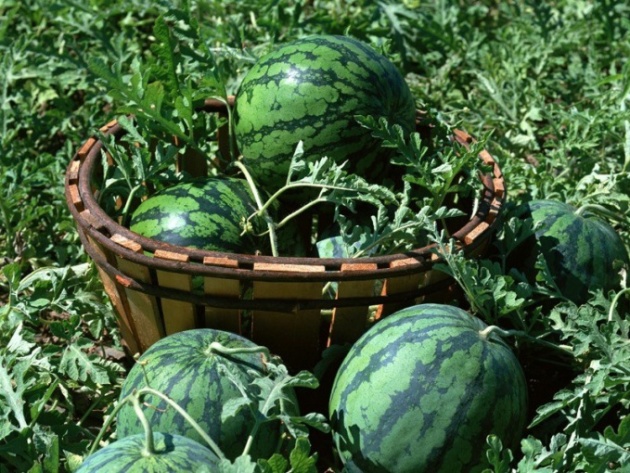
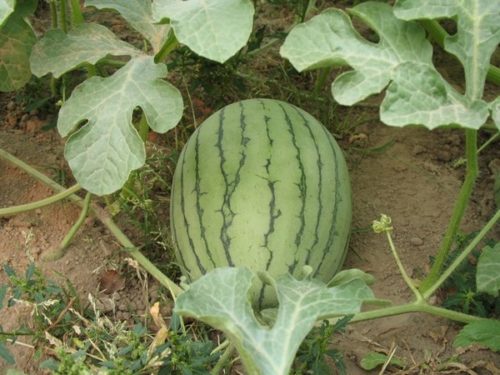
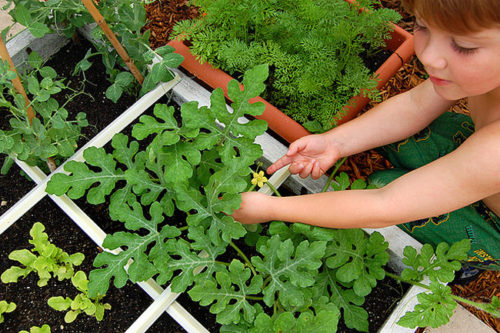

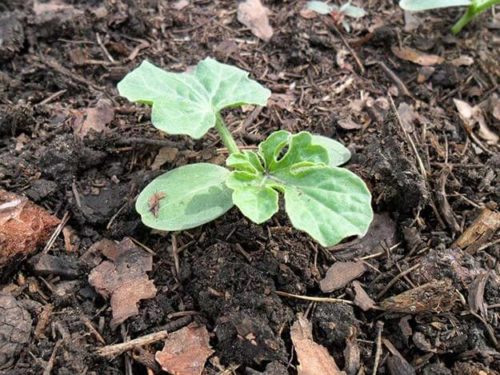
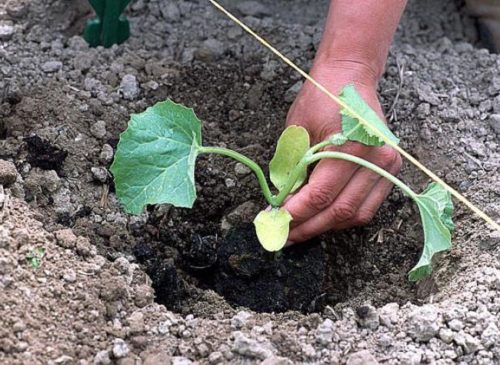

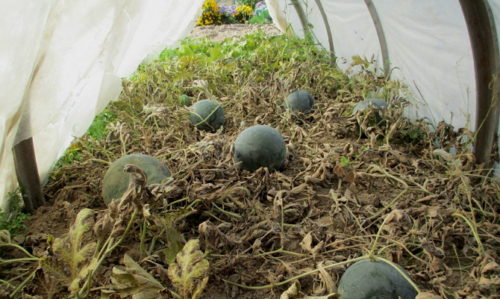
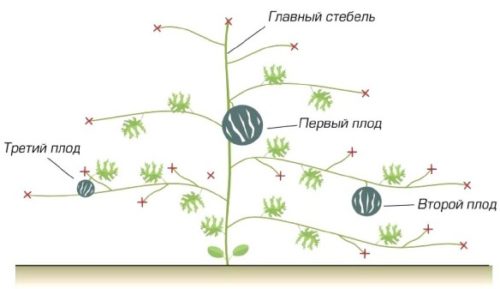
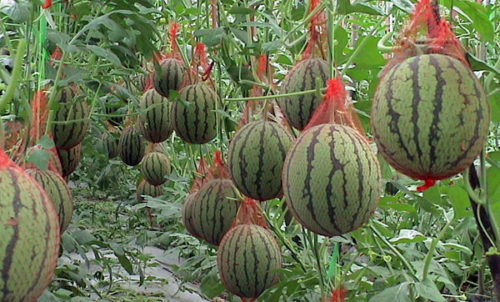
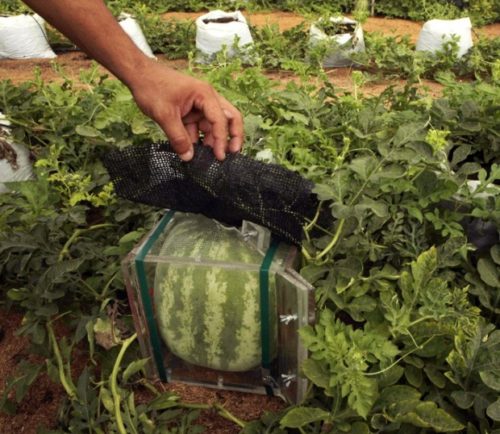

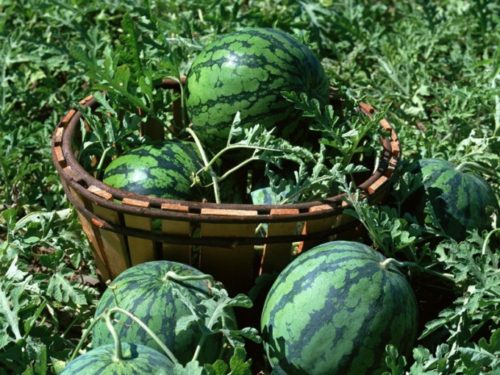













 Start a discussion ...
Start a discussion ...